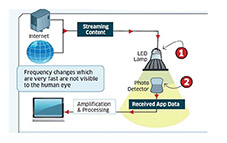The summer holiday season is here! It’s been good to have a few days off over Christmas and enjoy this little piece of paradise with friends and family.
It’s been great to keep in touch and there haven’t been many places I haven’t been able to get access to Wifi to check emails and generally carry on with business. Wifi is such a flexible and useful technology and I struggle to remember what it was like without it (although its less than 20 years old).
There are a lot of options for Wifi connectivity throughout the country including free Wifi hotspots. This means the holiday can have almost seamless connectivity. But what is the future of our internet connectivity, is Wifi still the best technology and what about LiFi?
Lifi was coined by Professor Haas in 2011 and stands for Light Fidelity. Essentially Lifi is delivered via a common household LED light that transmits data by a very fast flickering light (undetectable by the human eye). Every LED lamp is powered through an LED driver and this LED driver gets information from an Internet server that encodes the data. It is then picked up by a Photo Detector on the other end which is able to read all the flickering. It then decodes the data after Amplification and Processing (see diagram)
And as light travels faster than radio frequencies (WiFi), then the obvious advantage of this technology is the increase in speed that LiFi can transmit data at, about ten thousand times faster than radio waves. Indeed speeds are indicated to be up to 28 Gigabytes per second versus 7 Gigabytes for optimal Wifi speeds.
Practically however there are some disadvantages to Lifi, the most obvious is the bulb must be on to transmit data. This won’t please anyone who enjoys checking social media or news in bed at night. Also the range is limited; it is around 10 metres vs 30 metres for Wifi. And each light handles multiple connections so the more connected the slower the speed will become.
On the positive side it does mean it can have commercial appeal for industries where RF waves aren’t suitable. Think power stations and hospitals for example. And as light can travel through water this can be beneficial for underwater industries too.
Regardless of the limitations, the technology is certainly worth developing. What we have seen since its initial discovery is others looking at how to enhance it.
So, enter the introduction of infrared light LiFI. Still not commercialised but already we are seeing some examples at this year’s CES in Las Vegas which indicates it may not be far away.
The difference between LED LiFi and IR LiFI is a passive antenna located in the centre of the bulb/light that allocates a single beam to a connected device and then using optical light to transmit the data. One of the key advantages over the early Lifi is each light beam is allocated to individual devices (multiple connected devices slow down the speed).
It’s still early days but at the moment Lifi is still limited from a practical perspective, both Infrared and LED LiFi can’t transmit through walls, so while this could be an advantage from a security perspective, it’s a hard ask for your average user.
The mouth-watering speeds are exciting and further development is bound to push through the existing barriers.
The prototype of Infrared Lifi on show at CES has a lamp and a dongle that attaches to the PC (as our devices aren’t set up for this technology yet). The lamp is connected via an Ethernet cable and the dongle allows the PC to pick up the light.
The initial reports are it seems clunky, a bit of a hassle and costly. But plans are in place to allow this to be expanded to a room sized area.
The speeds though were very encouraging (currently beyond standard PC capability)
I think the take out from this, is a real push to commercialise this technology and already we are seeing some products hit the market and a number of new companies started around LiFi.
So it’s probably going to be some time before we have these awesome speeds where we need them and anywhere comparable to what Wifi offers us at the moment.
Our businesses perhaps will see the benefits first and I can certainly see some advantages to any light based data transfer technology, particularly when it comes to the Internet of Things and I suspect that is where the technology may be commercialised first.
So at this stage I think Wifi is still going to be the technology of choice and as it is flexible and very useful, so when working remotely while on holiday during the year, I hope your Wifi will do just enough to keep you in touch.


